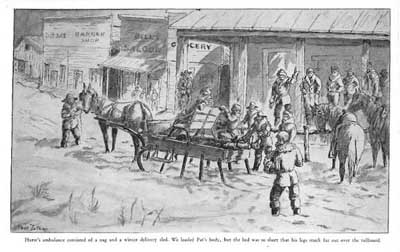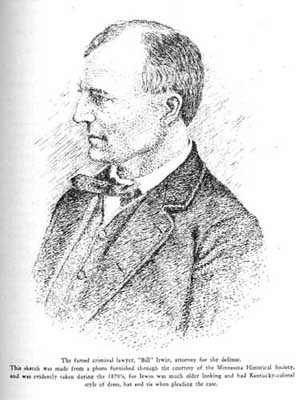|
New Year's eve was to be celebrated by holding an old-time dance to which everybody was invited; the Grand March to be led by Mayor Hanson and his lady. Comparative peace and order had prevailed for some time and it was due the head of the town to show due appreciation. Therefore, space had been cleared for dancing in the big machinery "emporium" and the local orchestra engaged to play. About all the town folks had gathered, including May, who still held the respect and admiration of the single men, even though the married women had ceased to invite her to tea parties. Billy decided he would be unwelcome at a party given in honor of his opposing clan and so he prepared to celebrate on his own account. He dressed up in his fringed deer-skin outfit, hung his six-shooter at his belt, donned his tan sombrero and went out to "round up" his friends and show them how to celebrate in real western style. The thermometer stood at thirty-two below zero when Billy walked into Boeing's Saloon at the corner next to Requa's Place. Like the others he had visited, there were no customers at the bar; the stud-poker tables were vacant; the fiddler was with the orchestra at the dance while the piano player thumped idly on the keys at the left front window inside the entrance doorway. Barkeeper "Gus" Olafson, white-aproned, had wiped the last of the used glasses and was leaning with elbows askew against the back bar waiting the next call for drinks. Billy already had liberally patronized his fourteen other competitors, and when he found no one present to call up for a drink, he ordered the pianist to come up and take one; the music-master refused with thanks. Gus was likewise commanded to take one and made similar reply. Billy pulled his long black Colts as he said to the piano player, "If you can't drink, suppose you dance," and placed a couple of shots close to the poor fellow's feet as an inducement; then turning to Gus, he remarked that he wanted to pay for a bottle of good liquor as he took aim at a quart which stood on the back bar close to where Gus stood. As Gus finished cleaning up the wreckage, Pat stepped in for a nip while on his way to the big dance. Billy was leaning on the bar with the reloaded gun still gripped in his right hand as Pat advanced after closing the door. "Come up you big Irish son of a b----- and have a drink on me," was Billy's salutation. Pat stood close, rested his foot on the rail, answering with a smile, "All right, Billy, but I'd just as soon you wouldn't use that kind of language to me." Billy swayed slightly as he stood erect and with his gun arm made a wide sweep as if to strike Pat's face with the point of the gun. To ward off the blow, Pat threw up his right arm with such force that it unbalanced Billy, who staggered along the bar backward with his gun arm sliding along the bar in the effort to regain his equilibrium, but the end of the bar left him without a support and he fell to the floor with his gun arm under his body. A turn of his stupefied form released the pinioned hand and raising it quickly he fired four times into Pat's body as he was advancing to help him from the floor. |
|
I had just closed the books for the day and was waiting in the lobby of the Lake Hotel for Doug. McNiven to get his buffalo coat from his room to wear to the dance. Noting the gun play through the plank partition which divided the hotel from the saloon, I stepped to the next door and entered, to see my friend Pat slump to expire on an empty beer case which stood in the corner at the right of the front door. Through the smoke the form of Billy was seen to disappear through the rear doorway. Sheriff Ever Wagness was passing as I opened the front door in search of help. Told the news, the sheriff deputized me with instructions to shoot Billy on sight; to stand guard at the door and control the crowd. Friends quickly gathered; Pat's body was stretched across a couple of poker tables for convenience in examination by the doctor, but he was dead; a bullet hole over the heart and two others in the body. Bar linens were drawn gently over face and breast to await the services of the undertaker. The crowd melted to go in search of the assassin. Deputies were stationed to form a cordon around the square, while the officers headed by the mayor searched within. A lynching party was organized for action as soon as he was driven from his hiding place which the deputies momentarily expected from the searching party. But midnight came and no capture had been made; the crowd was becoming restless. From his position the first deputy could look up the street leading to and beyond Pat's residence. Suddenly his attention was rivetted upon a ghostly form in flimsy house dress with hair streaming in the icy wind and uttering heart-rending screams as she ran swiftly toward his station at the corner. It was Kit. The woman was frantic; she had heard that Pat was dead. From the awful scene through the window she must be protected; to save her that crushing agony, the young deputy caught her in his arms, spread the folds of his big buffalo coat around her freezing form and held her until others came to his aid. They covered her with their quickly shed coats and furs and kindly neighbors carried her away. Meanwhile the search was proceeding under guard of the deputies in the alleys and outbuildings within the square. Ed Pierce, night watchman, withdrew from the crowd, and alone, went to investigate at the "Palace" where on gaining entrance, he found Billy standing at the top of the stairway with a gun in each hand. Ed explained to Billy and the girls that a lynching party was waiting for him. Annie had let him in and stood beside Ed at the door. She stood beside Billy pleading with him to give up his guns and go with Ed in a round-about way to be locked in the steel cell, where it might be possible to protect him from the angry mob. Silently they waded through the deep snow together and reached the jail, where Billy was securely lodged and several deputies placed on guard, before the crowd was aware of how it all happened. Word flew the rounds that Billy was in the steel cell. The mob went to get him there. They met with their own friends and associates armed with Winchesters, standing guard. Billy was in the strong hands of the law. The would-be lynchers retired to help load Pat's body on the one-horse cutter too short in the bed to hold it and so the undertaker drove away with Pat's legs sticking out like a couple of fence rails over the tailboard. |

|
Next day a strong guard accompanied the Sheriff and Billy to the train
and sent him to another section of the territory to be confined until
his trial was due, which the judge fixed for the coming April. Great
crowds came to Pat's funeral. He was buried on his own home lot at the
rear of the bungalow in which Kit had made him happy and contributed
much to his popularity in the boom town of the west. With assurance of
Billy's safe incarceration the intensity of public indignation slowly
subsided to await his trial for murder. As time for the hearing
approached, it was whispered about that the celebrated William W. Erwin
was to defend Billy in court. Erwin had a reputation as a criminal
lawyer second to none in the country--and it was deserved, for they
told that he had never lost a case. He often was called "The Tall Pine
of Minnesota." One writer said of him, "His height was above six feet
and he was slender and sinewy. He had a noble head and one of the most
peculiar pairs of eyes that human brow ever shaded. They were yellowish
tinge, as became the literally leonine cut of the man." His first
appearance in the National arena was in the defense of the Homestead
rioters when he shocked eastern courts with his wild western
mannerisms. He became an important attorney in labor litigation.
Meanwhile, May Munson held forth at the Palace where at times she might
have been observed peering out of an upstairs bedroom, her countenance
telling of the severe strain she lived under. She had to think of her
old friend Pat and the sufferings of his bereaved Kit alone at the
bungalow now; and she grieved for Billy behind strong iron bars,
waiting a verdict which might lead him to the scaffold of the hangman.
Kit came to offer consolation at her second floor apartment, from the
window of which they could see the steamer as she came into port. Below
stairs, scene of many a revelry, joyous and otherwise, now was gloomy
and inspired her with apprehension, for the authorities had ordered the
departure of the former occupants--all but May. Accompanied by Kit, May
was often seen dressed in somber colors doing necessary shopping about
town. Always her conduct was beyond reproach and she continued to hold
the respect of and was courteously treated by the townspeople. For the
trial a hastily constructed "bench and bar" was provided in the
machinery emporium; backless benches were set up for the accommodation
of a fair sized audience with limited room for the over-flow crowds. At
the left of the judge's stand, a door opened into a rude shed which
served for a jury room and when needed, a retiring room. The dreary
place was lighted by flickering lamps that tried the nerves of the
judge and lawyers alike. When the court convened crowds filled the
place; there were stalwart Indians in tribal costume; uniformed
officers from the fort and a motley crew of French trappers, squaw-men
and cowboys as well as Swedes, Norwegians and other settlers from the
surrounding country. Scattered all about the streets and vacant lots
could be seen the loaded bone-carts of the "breeds," driver and driven
making up a most incongruous picture, while here and there little knots
of white folks talked over the coming trial, for there was now no room
for them inside the Hall of Justice. |
 The famed criminal lawyer, "Bill" Erwin, attorney for the defense, was
later called the "Northwestern Whirlwind". This sketch was made from a
photo furnished through the courtesy of the Minnesota Historical
Society, and was evidently taken during the 1870's, for Erwin was much
older looking and had Kentucky-colonel style of dress, hat and tie when
pleading the case.
The famed criminal lawyer, "Bill" Erwin, attorney for the defense, was
later called the "Northwestern Whirlwind". This sketch was made from a
photo furnished through the courtesy of the Minnesota Historical
Society, and was evidently taken during the 1870's, for Erwin was much
older looking and had Kentucky-colonel style of dress, hat and tie when
pleading the case. |
|
||
| previous page |
|
next page |
|
|
||